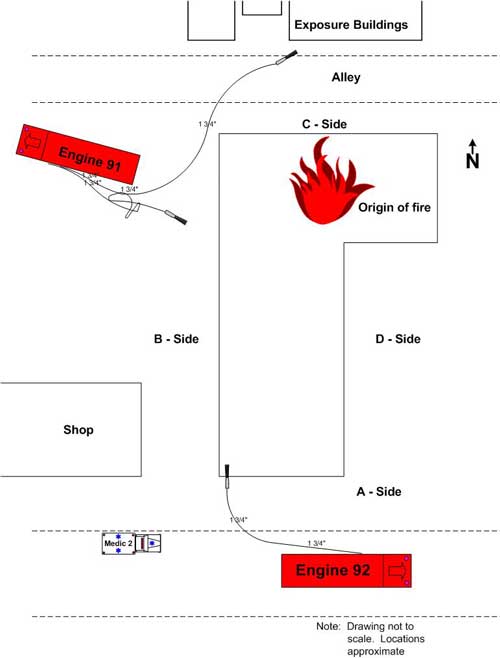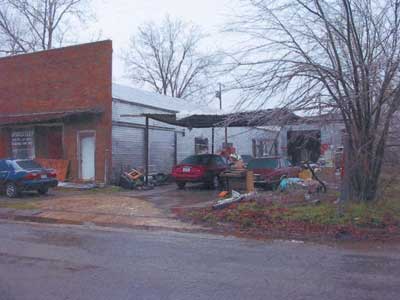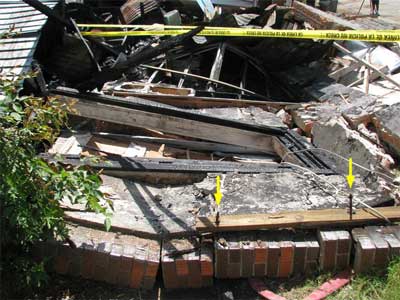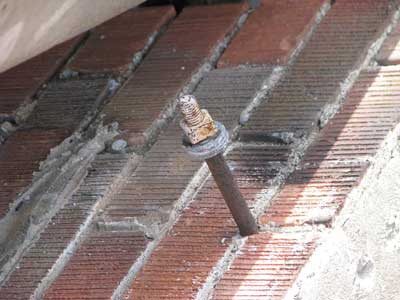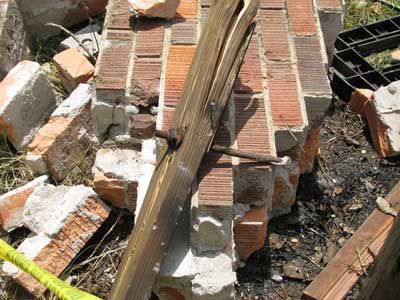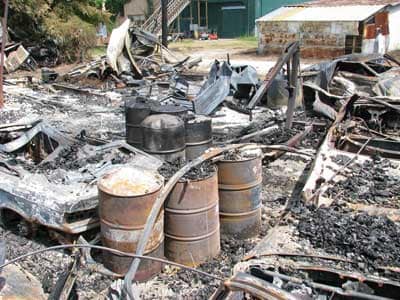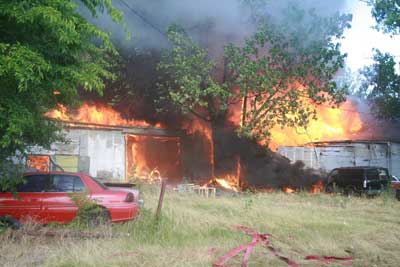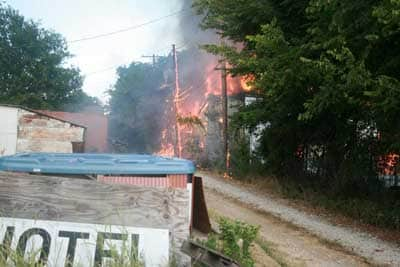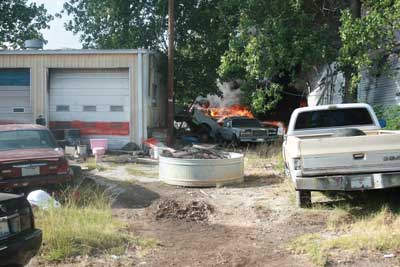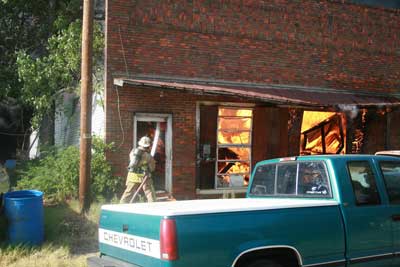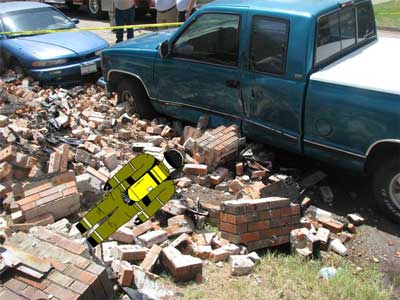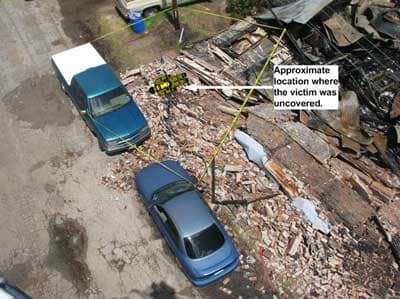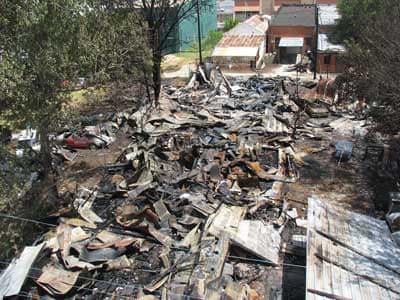Volunteer Fire Chief Killed when Buried by Brick Parapet Wall Collapse - Texas
 Death in the Line of Duty…A summary of a NIOSH fire fighter fatality investigation
Death in the Line of Duty…A summary of a NIOSH fire fighter fatality investigation
F2008-21 Date Released: March 12, 2009
SUMMARY
On July 05, 2008, a 42-year old male volunteer fire chief was killed when he was struck by a collapsing brick parapet wall during a commercial structure fire. The fire chief, along with four fire fighters, were finishing mopping up suppression activities at a grass fire when the fire department was dispatched to a structure fire. The fire chief and 2 fire fighters left the scene of the grass fire in a tanker and traveled to the scene of the structure fire where the fire chief began to size-up the burning commercial structure while the other 2 fire fighters traveled 5 blocks back to the station to obtain an engine and structural fire fighting gear. The 2 fire fighters returned to the structure fire scene with an engine parked in the street directly in front of the burning automotive repair and upholstery business. The fire chief grabbed a self-contained breathing apparatus (SCBA) from the engine and pulled a preconnected 1 ¾-inch handline to the front door, assisted by a fire fighter who had just arrived in her personal automobile. The fire chief worked the nozzle through the doorway (using tank water) while the other fire fighters established water supply. Less than 5 minutes after the engine arrived on scene and shortly after water supply was established, the brick parapet wall at the front of the structure collapsed, striking the fire chief and burying him under the brick debris. Rescuers quickly uncovered the fire chief and medical treatment was started immediately. The fire chief, still conscious, was transported to a trauma hospital where he died several hours later. Key contributing factors identified in this investigation include failure to conduct a 360-degree size-up of the incident site, failure to recognize the potential collapse hazard, inadequate staffing, and inadequate fireground communications.
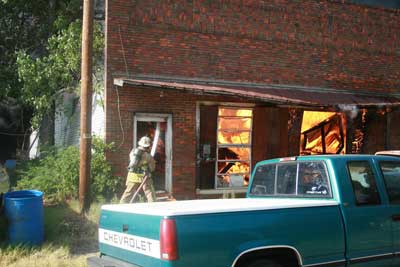 |
NIOSH investigators concluded that, to minimize the risk of similar occurrences, fire departments should:
- ensure the Incident Commander conducts a complete 360-degree size-up of the incident scene including evaluating the potential for structural collapse
- establish and monitor a collapse zone when conditions indicate the potential for structural collapse
- train all fire fighting personnel in the risks and hazards related to structural collapse
- ensure that the Incident Commander maintains the role of director of fireground operations and does not become involved in fire fighting efforts
- ensure that the Incident Commander conducts an initial size-up and risk assessment of the incident scene before beginning fire fighting operations and continuously re-evaluates the situation
- ensure that adequate numbers of staff are available to effectively respond to emergency incidents
- ensure that tactical operations are coordinated and communicated to everyone on the fireground
- ensure that every fire fighter on the fireground has a portable radio with sufficient tactical frequencies to effectively communicate on the fireground
- ensure that a separate Incident Safety Officer, independent from the Incident Commander, is appointed at each structure fire
While the following recommendations may not have prevented the death of the fire chief, fire departments should:
- develop, implement and enforce standard operating procedures (SOPs) or standard operating guidelines (SOGs) covering all aspects of structural fire fighting
- be prepared to use alternative water supplies to ensure adequate water is available for fire suppression
INTRODUCTION
On July 05, 2008, a 42-year old male volunteer fire chief was killed when he was buried by a collapsing brick parapet wall during a commercial structure fire. On July 7, 2008, the U. S. Fire Administration notified the National Institute for Occupational Safety and Health (NIOSH), Division of Safety Research (DSR) of this incident. NIOSH was also aware of the incident through national medial reports. On July 14th, two NIOSH investigators (a Safety Engineer and a Safety and Occupational Health Specialist) traveled to Texas to investigate the fatality. Meetings were conducted with the assistant fire chief, fire department officers and fire fighters, the city police chief, the city administrator, the city utility director and the mayor. During the course of the ensuing investigation, the NIOSH investigators met with and interviewed the officers and fire fighters involved in the incident as well as the fire chief from the first responding mutual aid department. The NIOSH investigators also met with and interviewed the three Emergency Medical Services (EMS) staff who had been on-scene and treated and transported the fire chief. The NIOSH investigators met with the chief deputy sheriff in charge of communications for the county in which the incident occurred to review fireground communication procedures. The site of the structure fire was visited and photographed. The NIOSH investigators reviewed the dispatch audio records, fire department training records, available standard operating procedures (SOPs) and photographs taken by the fire department photographer. The NIOSH investigators also discussed the incident with representatives of the State Fire Marshal’s office and reviewed photographs taken by the fire marshal’s office representatives. The turnout clothing and self-contained breathing apparatus (SCBA) worn by the Fire Chief at the time of the incident was inspected and photographed.
FIRE DEPARTMENT
The volunteer fire department involved in this incident serves a population of approximately 6,000 residents in an area of approximately 144 square miles. The response area consisted of a city of approximately 4,500 residents as well as suburban, ranch and woodland properties. The fire department had six trained Hazardous Materials (HazMat) technicians, including the victim, and maintained the only HazMat team in the county. At the time of the incident, the fire department had 30 members including the Chief, an Assistant Chief, two captains, a lieutenant and a safety officer. The fire department operates 2 engines, 2 tankers, a heavy rescue vehicle, a brush truck, a utility truck, and a HazMat trailer from one station. The fire department responds to structure fires, motor vehicle incidents, grass and brush fires, basic medical emergency calls, hazardous materials (HazMat) incidents, and rescues. Advanced life support is provided in the area by a career (paid) emergency medical services (EMS) provider. The department responded to 254 total incidents in 2007 and 265 total incidents in 2008. Many members were out of town for the holiday weekend at the time the incident occurred, which limited the number of members available to respond.
Note: At the time of the incident, the department had very limited written SOGs or SOPs that covered only the fire department organizational structure.
Training and Experience
In the state of Texas anyone over the age of 18 can become a volunteer fire fighter. Specific training requirements are determined by each fire department. The fire department involved in this incident required Texas basic fire fighter certification as part of the requirements for being a fire fighter. The state of Texas offers state fire fighter certification, roughly equivalent to National Fire Protection Association (NFPA) Level II Fire Fighter certification, through a number of accredited programs at universities and colleges across the state. Additional training provided by the fire department involved mostly hands-on training in basic fire fighting operations, tactics and procedures.
Training records provided by the fire department showed the fire chief had extensive fire service training including Fire Fighter I and II training from Texas A&M University; state certification as a volunteer, intermediate, and advanced volunteer fire fighter; HazMat Technician certification; Emergency Medical Services (EMS) and Paramedic certification; and Texas Fireman’s and Fire Marshal’s Association 167-hour basic fire fighter certification. The training records also indicated the fire chief had participated in a long list of training including training on structure fires, ground cover fires, thermal imaging camera (TIC) operations, weapons of mass destruction, helicopter safety, landing zone security, hybrid vehicle extrication, tunnel rescue, fire behavior, origin and cause, and many other topics.
The fire chief joined the local volunteer fire department in 1989 and became the fire chief in 1999. At the time of the incident, he was performing the duties of Incident Commander.
FIRE DEPARTMENT RADIO COMMUNICATIONS
The fire department only had seven portable radios for the entire department. These portable radios were assigned to the individual fire apparatus and were not sufficient in number to equip every fire fighter. The county dispatch center only had one main channel to dispatch and use on the fireground. The department did have a non-repeated tactical channel that could be used on scene, but other units from mutual aid departments as well as the dispatch center could not monitor this channel. Emergency communication features on the portable radios would not work on a non-repeated channel and if a mayday button was activated, it would not be received on a non-repeated channel.
EQUIPMENT and PERSONNEL
At the time of the incident, the fire department responded with Tanker 96, with a crew of 3, from the scene of a grass fire, and Engine 91, with a crew of 2, from the station. Brush Truck 97, with a crew of 2, was delayed leaving the scene of the grass fire due to mechanical problems. After dropping the Fire Chief off at the incident scene, the Tanker 96 crew drove to the station and returned in Engine 92. Two additional fire fighters arrived at the scene in their personally-owned-vehicles (POV) just after Engine 92 had arrived on-scene.
While enroute from the scene of the grass fire to the structure fire, the fire chief requested that the nearest mutual aid department (volunteer) be dispatched. The fire chief of the mutual aid department responded in a Quint apparatus (Ladder 81), arriving just after the wall collapse.
Shortly after the fire was confirmed, three additional mutual aid departments (all volunteer) were dispatched. All arrived at the incident scene subsequent to the wall collapse.
TIMELINE
Note: This timeline is a summary of events that occurred as the incident evolved. Not all events are included in this timeline. The times are approximate and were obtained by studying the dispatch records, witness statements, and other available information. In some cases, the times are rounded to the nearest minute. The times recorded on the dispatch log sheet (hand written) and the computer generated times associated with the electronic file recordings are several minutes off. The times listed in this report have been extrapolated from the electronic dispatch audio file records.
The response, listed in order of arrival (all times are approximate) and events, include:
1714 Hours:
- 911 dispatches local volunteer fire department for grass fire
1718 Hours:
- Tanker 96 enroute (fire chief (the victim), lieutenant, and fire fighter # 1)
Brush Truck 97 enroute (fire fighters # 2 and # 3)
1726 Hours:
- Tanker 96 and Brush Truck 97 on scene at grass fire
1730 Hours:
- Fire chief advises dispatch that grass fire is under control
1804 Hours:
- 911 phone call reporting fire at automotive repair and upholstery shop
1805 Hours:
- 911 dispatches fire department for structure fire
1806 Hours:
- Tanker 96 leaves scene of grass fire enroute to structure fire
Mutual aid department is dispatched
Medic 2 (3 Emergency Medical Services (EMS) personnel) enroute to fire scene
1809 Hours:
- Medic 2 on-scene. Confirms fire, gives scene size-up, reports exposure buildings are threatened, and identifies locations of two nearest hydrants
1810 Hours:
- 3 additional mutual aid departments are dispatched
1810-1814 Hours:
- Engine 91 arrives on-scene with 2 fire fighters (fire fighters # 4 and # 5) and positions near the rear of the structure on the B-side (See Diagram 1)
Medic 2 crew assists Engine 91 crew in pulling preconnected hand lines
1814 Hours:
- Ladder 81 (mutual aid fire chief) from first responding mutual aid department enroute
1815 Hours:
- Tanker 96 drops fire chief (victim) off at front (A-side) of the structure fire
1819 Hours:
- Brush Truck 97 (fire fighters # 2 and # 3) enroute to structure fire
1818 – 1820 Hours:
- Engine 92 on scene – lieutenant initiates hydrant connection while engine positions in front of the structure
Fire fighter # 6 arrives on-scene POV and assists in pumping Engine 91
Fire fighter # 7 arrives on-scene POV and assists fire chief in pulling handline to front of structure
Medic 2 checks exposure buildings for occupants and urges them to evacuate
1822 Hours:
- Front wall collapses, striking fire chief
Medic 2 radios dispatch requesting air evac helicopter
Fire fighters and bystanders immediately begin digging out fire chief
1833 Hours:
- Medic 2 enroute to helicopter landing zone transporting fire chief
PERSONAL PROTECTIVE EQUIPMENT
The fire department issues each fire fighter a full set of personal protective equipment including turnout pants, coat, helmet, boots, gloves, protective hood, and self-contained breathing apparatus (SCBA) with an integrated Personal Alert Safety System (PASS) device. At the time of the wall collapse, the fire chief was wearing his full array of personal protective clothing, was using his SCBA, and carrying a portable radio. The other fire fighters on scene did not have portable radios. The Medic 2 crew also carried portable radios.
STRUCTURE
The structure involved in this incident was a one-story, commercial structure containing a business that performed various automotive upholstery and repair work. The structure was built in the 1930s and had been renovated a number of times over the years. The structure was non-sprinklered and in a state of disrepair.
The structure was constructed of wood framing covered by sheet metal on three sides. The structure measured approximately 40 feet wide at the front (A-side) and extended approximately 140 feet back from the street. The structure contained an L-shaped addition of 34 feet by 40 feet at the rear (See Diagram 1). The front wall was covered with a brick façade approximately 20 feet high that extended several feet above the peaked ridgeline, forming a parapet (See Photo 1). The structure was estimated to measure 12-15 feet from floor to roofline. The parapet wall was connected to the structure by metal bolts approximately 12 inches long (see Photos 2 through 4). The floor was a concrete slab. A rain awning extended out from the front wall approximately 36 inches and was supported from above by steel rods connected to the brick façade. The roof was a peaked roof constructed of sheet metal over traditional roof rafters.
The fire is believed to have started in the rear of the structure in the automotive painting area. The structure was filled with various automotive parts, upholstery, gasoline, oil, paint, solvents and other highly flammable materials that contributed to the fuel load (See Photo 5). The fire quickly spread throughout the structure resulting in total involvement.
WEATHER
At the time of the incident, weather conditions in the area included a temperature of approximately 95 degrees Fahrenheit (F) with a dew point of 60 degrees F and a relative humidity of 30 percent. The sky was partly cloudy with light winds blowing from the southwest at approximately 9 miles per hour.1 There was no precipitation and the weather conditions were not a factor in the fatal incident. However, the locally dry conditions were conducive to promoting grass fires in the area.
INVESTIGATION
On July 05, 2008, at approximately 1714 hours, the local volunteer fire department was dispatched to a grass fire. The fire chief (the victim) along with four fire fighters responded in Tanker 96 (T96) and Brush Truck 97 (BT97). They arrived at a grass fire of about ¾ acre in size at 1726 hours after a travel time of approximately 8 minutes. Due to the holiday weekend, the availability of volunteer responders was limited. The grass fire was quickly brought under control and the fire chief radioed dispatch at 1730 hours that the fire was under control. As the crews were mopping up the grass fire, the fire department was dispatched to a reported structure fire at 1805 hours. The fire chief radioed dispatch that Tanker 96 was enroute to the structure fire at 1806 hours (with the fire chief, lieutenant and fire fighter # 1 onboard). Brush Truck 97 would not start and so was delayed in leaving the scene of the grass fire. Fire fighters # 2 and # 3 remained with BT97 at the scene of the grass fire.
While enroute to the structure fire, the fire chief radioed dispatch and requested that the closest mutual aid volunteer department be dispatched. Within minutes, the fire chief of the mutual aid department radioed Tanker 96 to inquire about what was needed. The fire chief stated he was enroute and wasn’t sure what was needed.
Three career EMS personal were on duty at the local career EMS department. They departed enroute to the scene of the structure fire in an ambulance (Medic 2). They arrived first on-scene at 1809 hours. All 3 EMS staff were trained fire fighters. They did a size-up and reported to dispatch that heavy smoke and fire was showing at the rear of the structure and the entire structure was fully involved. They reported that several exposure buildings to the rear of the structure were being threatened. They also reported the locations of the nearest hydrants. It is unknown whether the fire chief heard these radio reports.
A volunteer fire fighter (fire fighter # 4) was at the station waiting for the crews to return from the grass fire when he heard the dispatch for the structure fire. He started up Engine 91 and Engine 92 so they would be ready. When another fire fighter (fire fighter # 5) arrived at the station, they picked up their turnout gear and departed to the structure fire in Engine 91 at approximately 1810 hours. The Engine 91 departure and arrival times were not recorded on the 911 audio transcripts.
The Engine 91 crew could see thick dense black smoke as they departed the station. They heard the Medic 2 crew report over the radio that the fire was burning in the rear of the building. They drove past a hydrant located at the next corner west of the structure and decided not to connect to this hydrant as they would have to stretch their 5-inch supply line across the street which was one of the main north-south routes through town. The Engine 91 crew observed fire showing at the rear of the structure as they pulled into an empty lot adjacent to the B-side of the burning structure (See Diagram 1 and Photo 6). The three EMS personnel on Medic 2 helped the Engine 91 fire fighters stretch two 1 ¾ -inch preconnected hose lines toward the rear of the burning building.
The Engine 91 fire fighter # 5 took the nozzle of one 1 ¾-inch hose line down the alley behind the burning structure. The driver (fire fighter # 4) experienced trouble shifting the engine into pump gear and Medic 2 crew member # 1 assisted him in getting the pump set up. The Engine 91 fire fighter # 5 began using tank water in the alley to protect the exposure buildings directly behind the burning structure (see Photo 7). Two of the Medic 2 crew members ( # 2 and # 3) began checking the exposure buildings for occupants and to tell them to evacuate due to the fire. Medic 2 crew member # 2 continued clear around the block while crew member # 3 returned to the alley to help fire fighter # 5 drag the hose line. Note: Radio traffic suggests this took place in the time frame of 1818 to 1820 hours. It is unknown whether the fire chief heard this radio traffic or knew that Engine 91 was on-scene.
The Tanker 96 crew could see dense black smoke from the burning structure while enroute to the structure fire. The Tanker 96 crew drove one block north of the structure fire as they originally thought the burning structure was a boarding house located on another street. They turned right and south one block then turned west to reach the front of the burning structure facing south (See Diagram 1). At approximately 1815 hours, the fire chief instructed the lieutenant and fire fighter # 1 to return to the station (approximately 5 blocks away) on Tanker 96 to obtain an engine and structural fire fighting gear. The fire chief stated that he was going to do a 360 degree size-up of the structure that contained an automotive repair and upholstery business.
The lieutenant and fire fighter # 1 observed that Engine 91 was on-scene after they turned north on a side street as they drove to the station. They obtained Engine 92 and returned to the fire ground. The engine drove east passing a hydrant on the street in front of the burning structure. The lieutenant dismounted Engine 92 to connect the supply line to the hydrant and fire fighter # 1 positioned the engine in front of the burning structure, facing east. Note: The rear portion of the structure along the B-side was not visible from the front. A number of items including trees, brush, vehicles, and other items restricted the view along both sides of the structure so that the fire chief likely could not see the area where Engine 91 was positioned and the Engine 91 fire fighters likely could not see the fire chief at the front. The Engine 91 crew was unaware that Tanker 96 had driven past the front of the building and dropped off the fire chief (see Photo 8).
A volunteer fire fighter (fire fighter # 6) who was the regular driver on Engine 91 arrived on-scene in his privately-owned-vehicle (POV). He observed the lieutenant making the hydrant connection. The lieutenant instructed fire fighter # 6 to assist the Engine 91 crew and he took over E-91 pump operations so that the fire fighter who drove Engine 91 to the scene (fire fighter # 4) could put the second preconnected 1 ¾ inch handline into operation to knock down a grass fire that was threatening the exposure buildings across the alley.
The fire chief grabbed an SCBA from the engine and pulled a preconnected 1 ¾-inch handline to the front door, assisted by a fire fighter (fire fighter # 7) who had just arrived by POV. The driver (fire fighter # 1) immediately engaged the pump and the fire chief began spraying water through the front door near the A-B corner of the structure (see Photo 9). The water was briefly shut down when the supply line was connected and the hydrant opened, then the fire chief resumed spraying water at the front of the structure. Note: It is not clear how much of a size-up was conducted. The Engine 91 crew and the Medic 2 crew reported that they never observed the fire chief on the B or C sides of the structure. They never spoke with the fire chief on-scene and were not aware of the chief’s presence until after the wall collapse.
The fire chief and fire fighter # 7 discussed a possible entry into the structure. The fire chief instructed fire fighter # 7 to don an SCBA so she went to Engine 92 and quickly began to don an SCBA. Medic 2 crew member # 2 walked up to Engine 92 to tell the pump operator (fire fighter # 1 positioned at the middle pump control panel) of the fire conditions in the rear of the structure. Note: fire fighter # 1 and Medic 2 crew member # 2 reported that they could feel the heat of the fire at the pump control panel. Fire fighter # 1 also reported that flames were visible above the parapet wall at this point. As soon as the lieutenant finished making the supply hose connection to the hydrant, he walked toward Engine 92 to grab an SCBA and assist the fire chief. The lieutenant sized up the parapet wall as he approached the engine and he did not detect any threatening conditions. The fire department photographer was walking past the front of the structure taking photographs. The photographer and fire fighter # 1 also reported looking at the parapet wall without detecting any signs of pending collapse. (see Photo 9 which suggests full involvement and partial roof collapse at the time the photo was taken.) Note: The fire had been burning for at least 18-20 minutes at this point.
At approximately 1822 hours, less than 5 minutes after Engine 92 arrived on scene and shortly after water supply was established, the brick parapet wall at the front of the structure collapsed, just as the photographer and the lieutenant were walking past the side of Engine 92. Note: The fire chief had shut off the nozzle and was facing Engine 92 waiting for fire fighter # 7 to return to the hoseline. He was positioned approximately 5-10 feet from the doorway. The fire chief was struck by the collapsing wall, which buried him under the brick debris (see Photos 9 through 11). The collapse was witnessed by 3 fire fighters, one emergency services technician and several civilian bystanders. The Medic 2 crew immediately radioed dispatch and requested an air evac helicopter while other bystanders called 911 on cell phones. Rescuers quickly uncovered the fire chief and medical treatment was started immediately. The fire chief, still conscious, was transported via Medic 2 to a nearby landing zone at approximately 1833 hours. The fire chief was transferred to a helicopter and flown to a trauma hospital where he died several hours later during surgery.
Ladder 81 arrived on-scene just after the wall collapse. Brush Truck 97 departed from the scene of the grass fire at 1819 hours and arrived at the structure fire at 1826 hours. The lieutenant took over as Incident Commander and water supply to Engine 91 was established after the fire chief was transported. Once water supply was established to Engine 91 and Ladder 81, the lieutenant radioed dispatch that additional manpower was needed. A total of 7 fire departments worked at the scene extinguishing the fire.
CONTRIBUTING FACTORS
Occupational injuries and fatalities are often the result of one or more contributing factors or key events in a larger sequence of events that ultimately result in the injury or fatality. NIOSH investigators identified the following items as key contributing factors in this incident that ultimately led to the fatality:
- The failure to conduct a full 360-degree size-up of the incident site
- The failure to recognize potential collapse hazards
- Inadequate staffing to effectively and safely respond to a structure fire
- Inadequate fireground communications.
CAUSE OF DEATH
According to the County Coroner’s report, the cause of death was blunt force trauma to the chest, abdomen, and pelvis.
RECOMMENDATIONS
Recommendation # 1: Fire departments should ensure that the Incident Commander conducts a complete 360-degree size-up of the incident scene including evaluating the potential for structural collapse
Discussion: Whenever possible, a complete 360-degree size-up of the incident site should be conducted by the first arriving officer. A full 360-degree size-up around the outside perimeter of the structure allows the Incident Commander to “SEE” what has to be dealt with, such as construction issues, and possibly gain information to help determine the location and extent of where the fire is, where it was, and where it may be going. This information lays the foundation for the entire operation. The initial size-up as well as continuous evaluations should consider the potential for structure collapse. Retired Chief Alan Brunacini recommends that the arriving IC drive partially or completely around the structure whenever possible to get a complete view of the structure. While this may delay the IC’s arrival by a few seconds, this drive-by may provide significant details not visible from the command post.2 The size-up should include an evaluation of factors such as the fire size and location, length of time the fire has been burning, conditions on arrival, occupancy, fuel load and presence of combustible or hazardous materials, exposures, time of day, and weather conditions.
In this incident, it is unclear whether a complete 360-degree walk-around by the first arriving officer (the fire chief) was conducted. The Medic 2 crew conducted a size-up and broadcast their observations over the radio, but it is unknown whether the fire chief heard their report. The Medic 2 size-up, while helpful, should not be a substitute for a full 360-degree size-up by the first responding officer.
Recommendation #2: Fire departments should establish and monitor a collapse zone when conditions indicate the potential for structural collapse.
Discussion: During fire operations, two rules exist about structural collapse: (1) the potential for structural failure always exists during and after a fire, and (2) a collapse danger zone must be established.3-8 A collapse zone is an area around and away from a structure in which debris might land if a structure fails. The collapse zone area should be equal to the height of the building plus an additional allowance for debris scatter and at a minimum should be at least 1½ times the height of the building. In this incident, the structure was estimated to be 20 feet high at the top of the parapet wall so the collapse zone should have extended at least 30 feet from the structure.
Buildings can collapse due to the structural damage directly caused by a fire, or the activities of fire fighting operations. A fire department’s familiarity with types of construction in their community is an important tool in safely fighting fires. Once a collapse zone is established, fire departments should enforce a “no re-entry” policy unless approved by the Incident Commander.
Fire fighters need to recognize the dangers of operating near parapet walls or underneath overhanging awnings, porches, and other areas susceptible to collapse. Immediate safety precautions must be taken if factors indicate the potential for a building collapse. An external load, such as a parapet wall, steeple, overhanging porch, awning, sign, or large electrical service connections reacting on a wall weakened by fire conditions may cause a wall to collapse. Other factors include fuel loads, damage, renovation work, deterioration caused by the fire as well as pre-existing deterioration, support systems and truss construction.9, 10 A collapse is a possibility after fire involvement of more than 10 minutes but fire departments should not rely solely on time as a collapse predictor.10 The brick parapet wall which collapsed in this incident contained a rain awning supported by metal rods connected to the parapet wall (See Photo 1). In this incident, the presence of the brick parapet wall at the front of the structure, the condition of the structure (state of disrepair), and full fire involvement should have been indicators of a collapse hazard.
Recommendation #3: Fire departments should train all fire fighting personnel in the risks and hazards related to structural collapse.
Discussion: Proper training is an important aspect of safe fire ground operation. Both officers and fire fighters need to be aware of different types of building construction and their associated hazards.6, 8, 9 For example, collapsing roof systems can exert pressure on supporting exterior walls, increasing the potential for wall collapse. Different roof systems may collapse at different rates.10 While heavy timber roof systems will withstand more degradation by fire than lightweight engineered roof trusses, both types are subject to failure.10 Different phases of the fire suppression activities, such as the initial attack, offensive, defensive, and overhaul phases will have different hazards. However, the potential for collapse exists in any fire-damaged structure.10 One source of information related to structural collapse hazards is the National Institute of Standards and Technology, Building and Fire Research Laboratory (NIST / BFRL). A DVD containing videos and reports related to structural collapse can be obtained from the NIST websiteexternal icon http://www.nist.gov/el/. (Link Updated 1/17/2013)
Establishing priorities is another primary factor in safe fire ground operation that should be included in fire fighter training programs. The protection of life should be the highest goal of the fire service. When there is no clear danger to civilians, the first priority of firefighting should be the protection of fire fighters’ lives and when no other person’s life is in danger, the life of the fire fighter has a higher priority than fire containment or property consideration.11 In this incident, there were no indications of civilians in danger inside the structure.
Recommendation # 4: Fire departments should ensure that the Incident Commander maintains the role of director of fireground operations and does not become involved in fire fighting efforts.
Discussion: According to NFPA 1561, §7.1, “The incident commander shall have overall authority for management of the incident.”12 In addition to conducting an initial size-up, Incident Command must maintain a command post outside of the structure to assign companies, delegate functions, and continually evaluate the risk versus gain of continued fire fighting efforts. According to NFPA 1561, §7.1.7, the incident commander should take the following actions in establishing incident command:
Following the initial stages of an incident, the incident commander shall establish a stationary command post. In establishing a command post, the incident commander shall ensure the following: (1) The command post is located in or tied to a vehicle to establish presence and visibility. (2) The command post includes radio capability to monitor and communicate with assigned tactical, command, and designated emergency traffic channels for that incident. (3) The location of the command post is communicated to the communications center. (4) The incident commander, or his or her designee, is present at the command post.
NFPA 1561, §7.1.8 states that the incident commander shall continually conduct a thorough situation evaluation.
It is essential that adequate staff are available for immediate response to ensure that the Incident Commander is not required to become involved in firefighting efforts, thus reducing the IC’s ability to effectively coordinate and direct firefighting operations on the scene. Simply put, it is impossible, without great risk, for the IC to be involved in fire ground tactics while attempting to be in command. Additionally, if the first due company officer assumes initial incident command, that officer must separate themselves from the company officer role. Due to the holiday weekend, limited personnel were available to respond, causing the fire chief to become involved in fire suppression efforts which placed him in a position where he was unable to supervise the fireground operations “big picture.” Limited staffing also precluded the designation of a separate Incident Safety Officer.
Recommendation # 5: Fire departments should ensure that the Incident Commander conducts an initial size-up and risk assessment of the incident scene before beginning fire fighting operations and continuously re-evaluates the situation
Discussion: Among the most important duties of the first officer on the scene is conducting an initial size-up and risk assessment of the incident scene. This information lays the foundation for the entire operation. It determines the number of fire fighters and the amount of apparatus and equipment needed to control the blaze, assists in determining the most effective point for fire attack, the most effective method of venting heat and smoke, and whether the attack should be offensive or defensive. A proper size-up begins from the moment the alarm is received and it continues until the fire is under control. Several factors must be evaluated in conducting the size-up including: type of structure, time of day and potential occupancy, contents of the structure, conditions of the fire and smoke, and potential hazards. The size-up should also include assessments of risk versus gain during incident operations. 2, 6, 13-15 The size-up should include an evaluation of factors such as the fire size and location, length of time the fire has been burning, conditions on arrival, occupancy, fuel load and presence of combustible or hazardous materials, exposures, time of day, and weather conditions. Information on the structure itself including size, construction type, age, condition (evidence of deterioration, weathering, etc), evidence of renovations, lightweight construction, loads on roof and walls (air conditioning units, ventilation ductwork, utility entrances, etc.), and available pre-plan information are all key information which can effect whether an offensive or defensive strategy is employed. The size-up and risk assessment should continue throughout the incident. If pre-plan information is available, it should be the foundation for developing strategies and tactics. Fire departments should develop standard operating procedures (SOPs) or standard operating guidelines (SOGs) that identify size-up and risk assessment procedures. Fire departments should train on these procedures to ensure proper size-ups are done at actual incident scenes. In this incident, it is unclear whether the Incident Commander (the fire chief) did a full 360 degree size-up of the structure or if the IC was aware of the presence of the Engine 91 crew and Medic 2 staff operating at the rear B and C sides. It is also unknown whether the IC heard or used the size-up information reported over the radio by the Medic 2 staff upon their arrival first on-scene in any sort of risk assessment analysis.
Recommendation # 6: Fire departments should ensure that adequate numbers of staff are available to effectively respond to emergency incidents
Discussion: NFPA 1720 Standard for the Organization and Deployment of Fire Suppression Operations, Emergency Medical Operations, and Special Operations to the Public by Volunteer Fire Departments (2004 Edition) contains recommended guidelines for minimum staffing of volunteer fire departments.16 Chapter 4.1 states that fire suppression operations shall be organized to ensure that the fire department’s fire suppression capability includes sufficient personnel, equipment, and other resources to deploy fire suppression resources efficiently, effectively, and safely.
When fire departments know that staffing will be inadequate (and that is almost always predictable and can be planned for well before a call comes in), an aggressive automatic mutual aid response must be part of the dispatch process. Fire departments can plan ahead based upon anticipated fire flow (water) needs, along with community risk analysis (considering structure type/occupancies in the community, and threats to life safety), to predict what will be needed to respond on a first alarm. If the fire department cannot provide the staffing and equipment needed, then regional resources must be considered as part of the initial dispatch. Fire departments must operate on the most realistic worse case scenario. In this incident, limited personnel were available to respond to the grass fire and the structure fire due to the holiday weekend. Additional resources (mutual aid) including initially dispatched command staff support (such as an incident safety officer) may have helped prevent this line-of-duty death. A more defensive strategy until mutual aid departments arrived on-scene may also have changed the outcome.
Recommendation # 7: Fire departments should ensure that tactical operations are coordinated and communicated to everyone on the fireground.
Discussion: According to retired Fire Chief Alan Brunacini, the Incident Commander (IC) must be sensitive to the changing modes of the fire which can occur over minutes or hours, and not hesitate to order interior crews out of the structure when the situation is deteriorating.2 Incident commanders should ensure strategic management on the fireground. The point of strategic management is to prevent fire fighters from being in offensive positions under defensive conditions.2 The IC must identify the strategic mode as offensive or defensive through the analysis of an array of standard critical incident factors and their related characteristics. These include fire extent and location, savable occupants, fire effects (on buildings), savable property, entry and tenability, ventilation profile, special hazards, and resources available (fire fighters, equipment, water supply, etc). If a fire is unmanageable, it must be attacked with priorities given to protecting endangered exposures and stopping the forward progress of the fire. Every fire fighter on the fireground needs to be aware of the strategic mode of operation. In this incident, the mode of operation was not adequately communicated to all personnel on the fireground. The Engine 91 crew conducted defensive operations at the rear of the structure, focusing on protecting exposure buildings across the alley. The Engine 91 crew did not receive any instructions from the IC.
Recommendation # 8: Fire departments should ensure that every fire fighter on the fireground has a portable radio with sufficient tactical frequencies to effectively communicate on the fireground.
Discussion: National Fire Protection Association (NFPA) 1561, Standard on Emergency Services Incident Management System, Section 6.3 Emergency Traffic states: To enable responders to be notified of an emergency condition or situation when they are assigned to an area designated as immediately dangerous to life or health (IDLH), at least one responder on each crew or company shall be equipped with a portable radio and each responder on the crew or company shall be equipped with either a portable radio or another means of electronic communication.12 The U.S. Fire Administration report, Voice Radio Communications Guide for the Fire Service, 17 provides an overview of radio communication issues involving the fire service. Effective fireground radio communication is an important tool to ensure fireground command and control as well as helping to enhance fire fighter safety and health. Every fire fighter on the fireground should be provided with their own radio in case they become lost or separated from their crew. In this incident, the fire department only had seven portable radios for the entire department. Individual fire fighters did not carry radios. There was no communication on the fireground between the IC and the fire fighters in the front of the structure with the Engine 91 crew operating at the rear of the structure. Better radio communication may have added to the IC’s size-up of the incident scene and could have provided valuable information about the size and extent of the fire throughout the structure. This additional information may have influenced the IC to use more defensive tactics at the front of the structure (operating outside of the collapse zone).
Recommendation # 9: Fire departments should ensure that a separate Incident Safety Officer, independent from the Incident Commander, is appointed at each structural fire.
Discussion: According to NFPA 1561, Standard on Emergency Services Incident Management System, 2005 Edition, paragraph 7.1.1, “The Incident Commander shall have overall authority for management of the incident (7.1.1) and the Incident Commander shall ensure that adequate safety measures are in place (7.1.2).” This shall include overall responsibility for the safety and health of all personnel and for other persons operating within the incident management system. While the Incident Commander (IC) is in overall command at the scene, certain functions must be delegated to ensure adequate scene management is accomplished.12 According to NFPA 1500, Standard on Fire Department Occupational Safety and Health Program, 2007 Edition, “as incidents escalate in size and complexity, the incident commander shall divide the incident into tactical-level management units and assign an incident safety officer (ISO) to assess the incident scene for hazards or potential hazards (8.1.6).” 18 These standards indicate that the IC is in overall command at the scene, but acknowledge that oversight of all operations is difficult. On-scene fire fighter health and safety is best preserved by delegating the function of safety and health oversight to the ISO. Additionally, the IC relies upon fire fighters and the ISO to relay feedback on fireground conditions in order to make timely, informed decisions regarding risk versus gain and offensive versus defensive operations. The safety of all personnel on the fireground is directly impacted by clear, concise, and timely communications among mutual aid fire departments, sector command, the ISO, and IC.18
Chapter 6 of NFPA 1521, Standard for Fire Department Safety Officer, defines the role of the ISO at an incident scene and identifies duties such as recon of the fire ground and reporting pertinent information back to the Incident Commander; ensuring the department’s accountability system is in place and operational; monitoring radio transmissions and identifying barriers to effective communications; and ensuring established safety zones, collapse zones, hot zone, and other designated hazard areas are communicated to all members on scene.19 Larger fire departments may assign one or more full-time staff officers as safety officers who respond to working fires. In smaller departments, every officer should be prepared to function as the ISO when assigned by the IC. The presence of a safety officer does not diminish the responsibility of individual fire fighters and fire officers for safety. The ISO adds a higher level of attention and expertise to help the IC, fire officers, and fire fighters. The ISO must have particular expertise in analyzing safety hazards and must know the particular uses and limitations of protective equipment.19
The volunteer department involved in this incident had limited manpower and staffing at the incident scene which did not allow for the designation of a separate Incident Safety Officer. A designated safety officer could have assisted with continual size-up and timely communications regarding safety on the fireground, including the need to establish a collapse zone.
While the following recommendations may not have prevented the death of the fire chief, fire departments should consider whether their standard operating procedures (SOPs) or standard operating guidelines (SOGs) adequately cover the following items to ensure safe working conditions while operating at structure fires.
Recommendation # 10: Fire departments should develop, implement and enforce standard operating procedures (SOPs) or standard operating guidelines (SOGs) covering all aspects of structural fire fighting
Discussion: Written standard operating guidelines (SOGs) or standard operating procedures (SOPs) enable individual fire department members an opportunity to read and maintain a level of assumed understanding of operational procedures. Conversely, fire departments can suffer when there is an absence of well developed SOGs or SOPs. The NIOSH Alert: Preventing Injuries and Deaths of Fire Fighters identifies the need to establish and follow fire fighting policies and procedures.20 Guidelines and procedures should be developed, fully implemented and enforced to be effective.
The following NFPA Standards also document the need for written guidance for fire fighting operations that relate to the circumstances present during this incident, and identify best practices that can be incorporated into the SOGs and SOPs:
NFPA 1500, Fire Department Occupational Safety and Health Program, 2007 Edition, Chapter 4.1.2 states that fire departments shall prepare and maintain policies and standard operating procedures that document the organization structure, membership, roles and responsibilities, expected functions, and training requirements, including the following….(4) The procedures that will be employed to initiate and manage operations at the scene of an emergency incident.18
NFPA 1561, Standard on Emergency Services Incident Management System, 2005 Edition, Chapter 5.1.4 states that standard operating procedures (SOPs) shall include the requirements for implementation of the incident management system and shall describe the options that are available for application according to the needs of each particular situation.12
NFPA 1720, Standard for the Organization and Deployment of Fire Suppression Operations, Emergency Medical Operations, and Special Operations to the Public by Volunteer Fire Departments, 2004 Edition, Chapter 4.1.1 states that the authority having jurisdiction shall promulgate the fire department’s organizational, operational, and deployment procedures by issuing written administrative regulations, standard operating procedures, and departmental orders.16
Periodic refresher training should also be provided to ensure fire fighters know and understand departmental guidelines and procedures. Compliance with departmental SOPs / SOGs should be monitored and the appropriate action taken when non-compliance is identified. SOPs and SOGs should be applicable and common to mutual aid departments to insure consistency on the fire ground which can lead to a safer fire ground. At the time of the incident, the department had very limited written SOGs or SOPs that only covered the fire department organizational structure.
Recommendation # 11: Fire departments should be prepared to use alternative water supplies to ensure adequate water is available for fire suppression.
Discussion: Establishing adequate water supply on the fireground is an integral part of fire suppression. Regardless of the choice of attack method or the type of fire stream used, successful fire suppression depends upon discharging a sufficient quantity of water to remove the heat being generated, and ensuring that it reaches the fire rather than being turned into steam or being carried away by convective currents.11 Large fires may require the establishment of primary and secondary water supplies. In areas with hydrants, providing at least two water sources for a working structure fire is considered good practice. In areas with marginal or nonexistent water supply, establishing and providing an adequate water supply can be a substantial challenge.4 It is important to remember that a large flow of water for a short period of time may require less water and be more effective than a lesser flow over a longer period of time.4 Just as backup hose lines are needed inside structures, obtaining a second source of water is a good practice. This second source of water is essential at working fires, especially when operating off dead-end mains or limited flow hydrants. Water supply is not enhanced by securing a second source of water off the same dead-end main.4 Determining the number and size of hose lines to deploy at a fire can be estimated by first estimating the size of the structure and applying various flowrate calculations such as what is taught at the U.S. National Fire Academy (area divided by 3) or by estimating the size of the fire. Retired Chief Alan Brunacini in his book Fire Command states “Big Fire = Big Water, Little Fire = Little Water.”2 Calculating flowrate requirements and identifying primary and secondary water sources should be part of the incident pre-planning process.
In addition to the location and extent of the fire, factors affecting selection and placement of hose lines include the building’s occupancy, construction, and size. In addition, fire load and material involved, mobility requirements, and numbers of persons available to handle the hose lines are important factors.
In this incident, Engine 91 bypassed a hydrant on the street in front of the structure as they didn’t want to lay their supply line across a side street and block traffic. Later, Engine 92 connected to this same hydrant after positioning in the street in front of the structure. Applying the U.S. National Fire Academy rule (area divided by 3) to this fire indicates flow rates above 1800 gallons per minute were needed to effectively extinguish the fire.
REFERENCES
- Weather Underground [2008]. Weather history for Texas, July 5, 2008external icon. http://www.wunderground.com/history/airport/KCRS/2008/7/5/DailyHistory.html?req_city=Teague&req_state=TX&req_statename=Texas Date accessed: September 19, 2008.
- Brunacini AV [1985]. Fire command. Quincy, MA: National Fire Protection Association.
- Dunn V [1988]. Collapse of burning buildings, a guide to fireground safety. Saddle Brook, NJ: PennWell.
- Klaene BJ and Sanders RE [2000]. Structural fire fighting. Quincy, MA: National Fire Protection Association, pp 101-117.
- Dodson D [1999]. Fire department incident safety officer. New York: Delmar Publishers.
- NIOSH [1999]. NIOSH alert: preventing injuries and deaths of fire fighters due to structural collapse. Cincinnati, OH: U.S. Department of Health and Human Services, Public Health Service, Centers for Disease Control and Prevention, National Institute for Occupational Safety and Health, DHHS (NIOSH) Publication No. 99-146.
- Delmar Publishers [2000]. Fire fighter’s handbook: essentials of fire fighting and emergency response. New York: Delmar Thomson Learning.
- NIOSH [2005]. NIOSH alert: preventing injuries and deaths of fire fighters due to truss system failures. Cincinnati, OH: U.S. Department of Health and Human Services, Public Health Service, Centers for Disease Control and Prevention, National Institute for Occupational Safety and Health, DHHS (NIOSH) Publication No. 2005-132.
- NIOSH [2007]. Career fire fighter dies and chief is injured when struck by 130-foot awning that collapses during a commercial building fire – Texas. Morgantown, WV: U.S. Department of Health and Human Services, Public Health Service, Centers for Disease Control and Prevention, National Institute for Occupational Safety and Health. FACE Report F2007-01.
- Brannigan FL [1999]. Building construction for the fire service, 3rd ed. Quincy, MA: National Fire Protection Association, pp 517-563.
- Dunn V [1992]. Safety and survival on the fireground. Saddle Brook, NJ: Fire Engineering Books and Videos. Pp285-292.
- NFPA [2005]. NFPA 1561: Standard on emergency services incident management system. 2005 edition. Quincy, MA: National Fire Protection Association
- Dunn V [2000]. Command and Control of Fires and Emergencies. Saddle Brook NJ: Fire Engineering Book and Videos.
- Dunn V [1998]. Risk management and lightweight truss construction. New York: WNYF, Official training publication of the New York City Fire Department, 1st issue.
- IFSTA [2008]. Essentials of fire fighting, 5th ed. Oklahoma State University. Stillwater, OK: Fire Protection Publications, International Fire Service Training Association.
- NFPA [2004]. NFPA 1720: Standard for the Organization and Deployment of Fire Suppression Operations, Emergency Medical Operations, and Special Operations to the Public by Volunteer Fire Departments, 2004 Edition. Quincy, MA: National Fire Protection Association
- USFA [2008]. Voice Radio Communications Guide for the Fire Service. U.S. Fire Administration, Federal Emergency Management Agency, U.S. Department of Homeland Security. Emmitsburg, Maryland. October 2008.
- NFPA [2007]. NFPA 1500: Fire department occupational safety and health program. Quincy, MA: National Fire Protection Association.
- NFPA [2008]. NFPA 1521: Standard for fire department safety officer. 2008 Edition. Quincy, MA: National Fire Protection Association.
- NIOSH [1994]. NIOSH alert: preventing injuries and deaths of fire fighters. Cincinnati, OH: U.S. Department of Health and Human Services, Public Health Service, Centers for Disease Control and Prevention, National Institute for Occupational Safety and Health, DHHS (NIOSH) Publication No. 94-125.
INVESTIGATOR INFORMATION
This investigation was conducted by Timothy Merinar, Safety Engineer, and Stephen T. Miles, Safety and Occupational Health Specialist (and retired Battalion Chief of Safety, Virginia Beach Fire Department), with the NIOSH, Fire Fighter Fatality Investigation and Prevention Program, Surveillance and Field Investigations Branch, Division of Safety Research, NIOSH. An expert technical review was provided by Deputy Chief William Goldfeder, Loveland-Symmes Fire Department (Ohio) and editor of http://www.FireFighterCloseCalls.comexternal icon. This report was authored by Timothy Merinar.
ADDITIONAL INFORMATION
The Texas State Fire Marshal’s Office conducted a separate investigation of this incidentexternal icon. Their investigation report will be available at http://www.tdi.texas.gov/fire/fmloddinvesti.html. (Link Updated 1/17/2013)
photos and Diagrams
|
The National Institute for Occupational Safety and Health (NIOSH), an institute within the Centers for Disease Control and Prevention (CDC), is the federal agency responsible for conducting research and making recommendations for the prevention of work-related injury and illness. In fiscal year 1998, the Congress appropriated funds to NIOSH to conduct a fire fighter initiative. NIOSH initiated the Fire Fighter Fatality Investigation and Prevention Program to examine deaths of fire fighters in the line of duty so that fire departments, fire fighters, fire service organizations, safety experts and researchers could learn from these incidents. The primary goal of these investigations is for NIOSH to make recommendations to prevent similar occurrences. These NIOSH investigations are intended to reduce or prevent future fire fighter deaths and are completely separate from the rulemaking, enforcement and inspection activities of any other federal or state agency. Under its program, NIOSH investigators interview persons with knowledge of the incident and review available records to develop a description of the conditions and circumstances leading to the deaths in order to provide a context for the agency’s recommendations. The NIOSH summary of these conditions and circumstances in its reports is not intended as a legal statement of facts. This summary, as well as the conclusions and recommendations made by NIOSH, should not be used for the purpose of litigation or the adjudication of any claim. For further information, visit the program website at www.cdc.gov/niosh/fire or call toll free 1-800-CDC-INFO (1-800-232-4636).
|
This page was last updated on 03/16/09.

